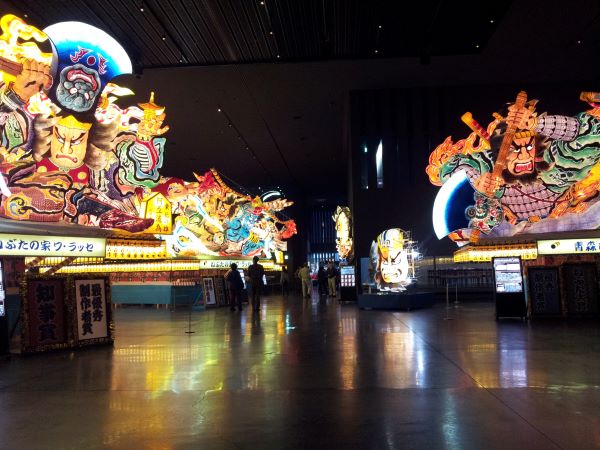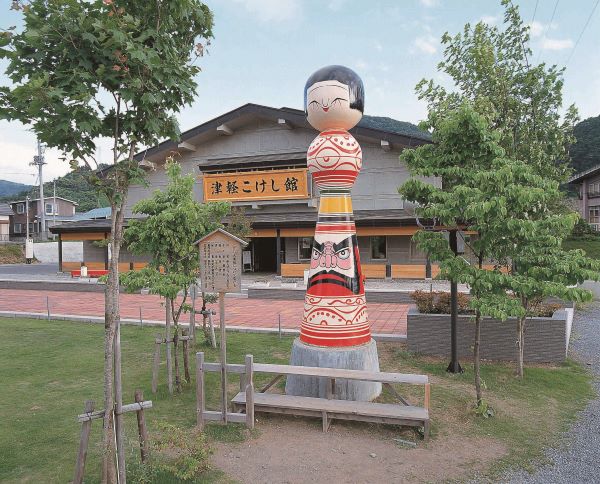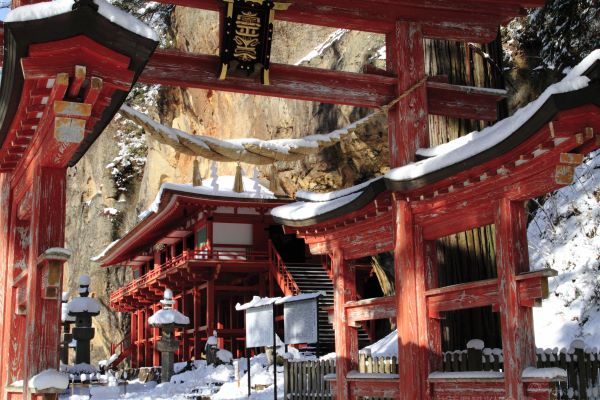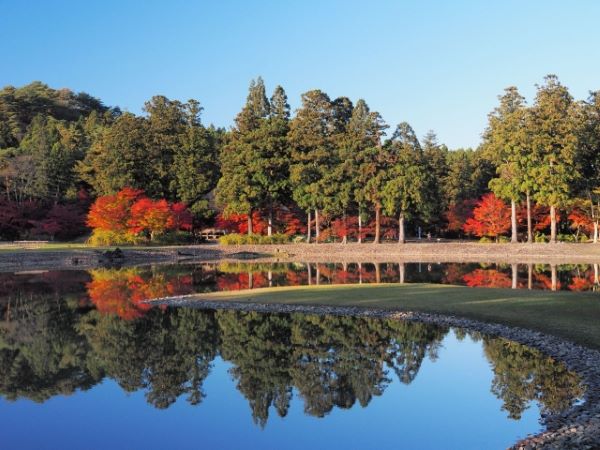If you like to spend time in museums, Aomori is probably the best city to visit in the Tōhoku region. While a large part of the city is covered by nature, it surprisingly has many museums scattered throughout. Unlike Hirosaki, which is a 45-minute train ride away, Aomori has more variety. Whether you like contemporary art museums or something cultural or historical, you won’t be disappointed by the museums here!
Table of Contents
- Nebuta Museum WA RASSE (ねぶたの家 ワ・ラッセ)
- Seikan Train Ferry Memorial Ship Hakkōda-maru (青函連絡船メモリアルシップ八甲田丸)
- Aomori City Forestry Museum (青森市森林博物館)
- Aomori Prefectural Museum (青森県立郷土館)
- Munakata Shikō Memorial Hall (棟方志功記念館)
- Aomori Museum of Art (青森県立美術館)
- Sannai Maruyama Special Historical Site (三内丸山遺跡)
Nebuta Museum WA RASSE (ねぶたの家 ワ・ラッセ)
Different from its stylish and modern looks, the Nebuta Museum WA RASSE is a facility for one of Japan’s representative festivals that has a long history, the Aomori Nebuta Festival ( 青森ねぶた祭り).
You must have seen the floats that appear in Japanese festivals. In Aomori, however, the gigantic lantern floats were built to convey a scene in well-known legends or historic characters instead of in the shape of portable shrines. These floats are called ‘Nubuta’ in Aomori.


In 2011, the Nebuta Museum WA RASSE was opened to display these colorful and powerful-looking floats, so no matter when you visit Aomori, you get to be amazed by the festival full of energy!
In the museum, you will discover the origin and history of the Nebuta and Nebuta Festival. You can also learn the Haneto Dance that is danced during the festival.
For more information, please refer to the official website HERE.
The average time spent in the museum is around 30 – 60 minutes.
Tip: If you want to join the Haneto Dance, check with the staff to see if it is still possible to re-enter the museum on the same day. You can visit other attractions nearby and come back for the dance session.
Nebuta Museum WA RASSE’s Opening Hours, Admission Fee, and Access Information
- The museum is open from 9 am to 7 pm from May to August. From September to April, it closes early at 6 pm.
- The last admission is 30 minutes before the closing time.
- The museum is closed on the 9th and the 10th of August and the 31st of December, and the 1st of January.
- The admission fee is
- 620 yen for adults
- 460 yen for senior high school students
- 260 yen for elementary and junior high school students
- You can also get a combo ticket for access to Seikan Train Ferry Memorial Ship Hakkōda-maru (青函連絡船メモリアルシップ八甲田丸) and/or Aomori Prefecture Tourism Information Center ASPAM (青森県観光物産館アスパム). Please refer to HERE for more information.
- Nebuta Museum WA RASSE is just a one-minute walk away from JR Aomori Station (青森駅).
Tip: If you are driving, you will get 60 minutes of free parking if you park at their car park. Please bring your admission ticket and parking ticket to the reception.
Seikan Train Ferry Memorial Ship Hakkōda-maru (青函連絡船メモリアルシップ八甲田丸)

Back in the good old days, when Hokkaidō wasn’t connected to Japan’s main island Hōnshu, the only way to get to Hokkaidō was by ferry (airplanes didn’t come into the picture until later on as well). This led to the birth of the ferry route, the Seikan Route, which was used for 80 years from 1908.
The Seikan Ferry (青函連絡船) was how the then national railway, Japan Railway, carried its customers between Aomori (Station/Port) and Hakodate (Station/Port). The ferry service operated on the 113 km Seikan Route (青函航路).
Up until 1988, 55 Seikan Ferries transported around 160 million passengers and 250 tones of freights.
Hakkōda-maru, which had been in service since 1964, was the Seikan Ferry that has operated the longest (23 years and 7 months). It is also the last Seikan Ferry in history. After reaching Aomori Port in March 1988, it was permanently moored and turned into a Seikan Ferry Museum in 1990.
Inside Hakkōda-maru
Strolling around the entire ferry that has a total of 5 levels, including the underdeck engine room, will probably only take you less than 60 minutes.
One of the most fascinating exhibits is the postal train carriage displayed on the first-floor deck. As rare as it is, the ferry has a space to transport railroad vehicles!

A ticket is required to get to the museum on the third floor. In the museum, you will see tools that were used at the time when the ferry was in service. Humanoids are also used to show Aomori citizens’ lifestyles in the 1950s and 1960s. The museum’s highlight is probably models of various Seikan Ferries, historical documentation, and photographs of the history of the Seikan Route.
From the top floor of the ferry, you can get a panoramic view of Aomori Port (closed in winter).
Other parts of the ferry open to the public include the Green Cabin (the equivalent of the green carriage on a bullet train), sleeper room, meeting rooms, and captain’s room.
A similar facility is moored at Hakodate Port if you have been to Hakodate. Together with the Hakodate City Seikan Train Ferry Memorial Museum Mashū-maru (函館市青函連絡船紀念館摩周丸), your understanding of the history of the Seikan Route will be complete!
Seikan Train Ferry Memorial Ship Hakkōda-maru’s Opening Hours, Admission Fees, and Access Information
- The opening hours are from
- 9 am to 7 pm from April to October
- 9 am to 5 pm from November to March
- The last admission is at 6 pm in the summer months and at 4:30 pm from November to March.
- It closes on Mondays between November and March.
- If Monday is a public holiday, it will close on the next business day.
- It also closes on the weekdays on the 2nd week of March.
- The admission fee is
- 510 yen for adults
- 310 yen for high school students
- 110 yen for elementary school students
- The museum is less than a 5-minute walk.
Tip: Refer to the combo ticket information under Nebuta Museum WA RASSE’s admission fee section HERE to save.
Aomori City Forestry Museum (青森市森林博物館)

Aomori City Forestry Museum was the building of the Aomori Forestry Bureau from 1908 until the late 1970s. As the Bureau was getting a new building as one of the projects commemorating the 80th anniversary of the enforcement of the city system, the old building was transformed and opened as a forestry museum in November 1982.
The exhibits in the museum are quite interactive, making it easy for amateurs to understand deep forestry, the hinoki wood produced in Aomori Prefecture, and the importance of forests.
What is also on display are the vehicles running on the Tsugaru Forest Railway in the past century. The carriages are now certified forestry heritages.


The only thing about the museum is the lack of English explanations. Almost all descriptions and notes about the exhibits are in Japanese only.
So, it is probably a place for those interested in architecture from the Meiji period (1868 – 1912). Not only its appearance, the interior of the building still largely reflects what it looked like a century ago.
Aomori City Forestry Museum’s Opening Hours, Admission Fees, and Access Information
- The museum is open from 9 am to 5 pm. From November to March, it closes early, at 4:30 pm.
- It closes on Mondays and from the 28th of December to the 4th of January.
- If Monday is a public holiday, it will close on the next business day.
- The admission fee is
- 250 yen for adults
- 130 yen for high school and university students
- Free otherwise and for elderly who are 70 years old and above
- From JR Aomori Station’s (青森駅) west exit, it is around a 10-minute walk. You can also take Nogiwa Danchi (野木和団地) and Ushirogata (後潟) Lines that are bound for Abura River (油川) and get off at Shinrin Hakubutsukan-mae (森林博物館前) from bus stop no. 6.
- From Shin-Aomori Station (新青森駅)’s bus stop no. 1 at the south exit, take buses bound for the city center (市中心部)/Kenritsu Chūō Byōin (県立中央病院) and get off at Nishi Kami Furukawa (西上古川). From there, it is around a 13-minute walk.
Aomori Prefectural Museum (青森県立郷土館)
Important: Aomori Prefectural Museum is temporarily closed.
Not too far from ASPAM, the Aomori Prefectural Museum was founded for visitors to think about the future after looking back on the prefecture’s history and what is happening at present.

The museum aims to make it easy for anyone to understand the history and nature of Aomori Prefecture. You can find out about Aomori’s archeology, nature, history, and folklore through dioramas, models, and audiovisual images.
Special exhibitions will be held in the museum as well.
For more information about what is on display, please refer to their website HERE.
The museum used to be the main branch of the Former Aomori Bank. The building that was completed in 1931 was gifted to the prefecture in 1969.
If you don’t have time to visit the World Heritage Site, Sannai Maruyama Special Historic Site, you can stop by this museum to get a degree of understanding of the Jōmon civilization.
There is also a corner for you to find out about Aomori’s most well-known specialty – Apples! It is just amazing how many different kinds of apples there are out there!


Aomori Prefectural Museum’s Opening Hours, Admission Fees, and Access Information
- For the museum’s opening hours, admission fees, and access information, please refer to their website HERE.
- On top of the opening hours information on their English website, the museum will also close on the days that are marked in blue color with “休館日” written on the calendar on their Japanese website HERE.
Munakata Shikō Memorial Hall (棟方志功記念館)
Munakata Shikō born in Aomori City was a well-known woodblock printmaker in the Shōwa period. Born as the third son of a Swordsmith family, he wasn’t interested in making swords but was inspired by the artworks of Vincent van Gogh, which made him aim to become a Western-style painter.
The artist who was active globally won several international awards during his 50s. This subsequently led to his recognition by the Japanese government in 1970 when he was awarded the Order of Culture (文化勲章), which is the highest honor in the arts field that a Japanese can obtain.

The international awards he was awarded include the “Prize of Excellence” at the Second International Print Exhibition in Lugano, Switzerland in 1952, the first prize at the São Paulo Bienal Exhibition in Brazil in 1955, followed by the Grand Prix at the Venice Biennale in 1956.
In 1975, the same year that he passed away, this memorial hall was opened to commemorate his achievement and exhibit his artworks.
The Artworks Exhibited in Munakata Shikō Memorial Hall
Inside the memorial hall, you will find a wide range of his works, such as woodblock prints, oil paintings, and calligraphy, making it the facility with the largest collection of Shikō Munakata’s works in Japan.
As the space in the exhibition room is limited, instead of cramping all the collections that the memorial hall holds, only a part are on display.

Although it is a shame that we can’t appreciate all of the collections in one go, this enables us to examine his work one by one closely. What is on display is changed four times a year. Along with the artworks, materials such as the tools he used are also exhibited.
If you want to know what artworks are on display before your visit, refer to their website HERE.
Tip: The average time visitors spend at Shikō Munakata Memorial Hall is around 30 to 90 minutes (depending on if you are interested in a video of Shikō Munakata, which lasts 38 minutes).
Munakata Shikō Memorial Hall’s Opening Hours, Admission Fees, and Access Information
- The memorial hall is usually open from 9 am to 5 pm. But from November to March, it opens late at 9:30 am.
- It closes on Mondays but will open on public holidays and between Nebuta Festival from the 2nd to the 7th of August.
- Please also refer to their calendar HERE for other days that the museum will be closed.
- The admission fee is
- 550 yen for adults
- 300 yen for university students
- 200 yen for high school students
- Free otherwise
- From JR Shin-Aomori Station (新青森駅) or JR Aomori Station (青森駅).
- Take Nebutan-gō (ねぶたん号) and get off at Munakata Shiko Kinenkan-mae (棟方志功記念館).
- From JR Shin-Aomori Station (新青森駅), you can also take the local bus from bus stop no. 1 bound for either Tōbu Eigyōjo (東部営業所) or Kenritsu Chūō Byōin (県立中央病院) and get off at Tsutsumi-bashi (堤橋).
- From the bus stop, it is a 10-minute walk.
- From JR Aomori Station (青森駅), you can take
- Yokouchi Loop Line (横内環状線) or services bound for Tsutsumi-bashi (堤橋) from bus stop no. 3 and get off at Munakata Shikō Kinenkan-dōri (棟方志功記念館通り).
- From the bus stop, it is less than a 4-minute walk.
- There are also other services that you can take. Please check with the station staff when you get there.
- Yokouchi Loop Line (横内環状線) or services bound for Tsutsumi-bashi (堤橋) from bus stop no. 3 and get off at Munakata Shikō Kinenkan-dōri (棟方志功記念館通り).
Tip: Show your ticket to the Aomori Museum of Art to get a discount for your admission ticket at the memorial hall.
Aomori Museum of Art (青森県立美術館)
If you like to spend time in art galleries and museums, take a bus to the Aomori Museum of Art.
The museum, which is on the ground of the Sannai Maruyama Special Historical Site (三内丸山遺跡), is one of the top art museums in the northern Tohoku region (another facility that goes hand in hand with it is the Towada Art Center in Towada City).
For more information about the fascinating artworks that the museum is exhibiting, please refer to our article on the Aomori Museum of Art!
Sannai Maruyama Special Historical Site (三内丸山遺跡)
While the world was panicking about the once-of-a-lifetime pandemic, in March 2021, Aomori Prefecture proudly welcomed another world heritage title.
The Sannai Maruyama Special Historical Site completely overturned the understanding of the Jōmon civilization, was registered as a part of Jōmon Prehistoric Sites in Northern Japan (北海道・北東北の縄文遺跡群) as a World Heritage.
For more information about this World Heritage site, please refer to our article on the Sannai Maruyama Special Historical Site!
Find Out Where Else to Go in Aomori
Aomori City, the capital of Aomori Prefecture, has a wealth of beautiful nature, such as the Hakkōda mountain ranges and Mutsu Bay. Stunning scenery can be adorned throughout the year. In the fall, it is time to find out your favorite kinds of apples!
The city also has a couple of cultural heritages for you to enjoy a different side of Japanese culture.
For more information, please refer to our article on Aomori!






